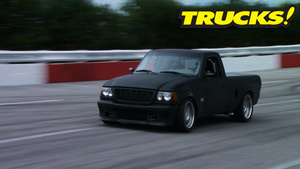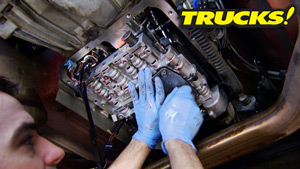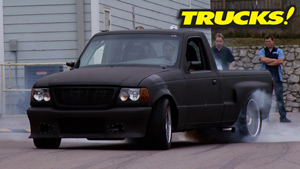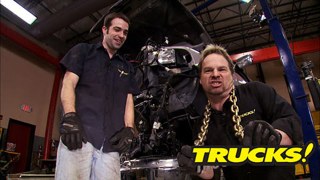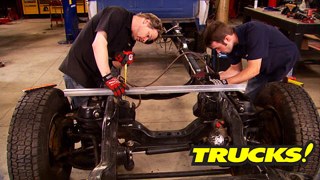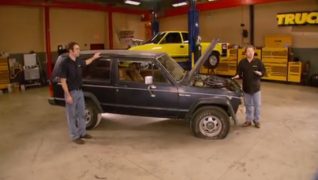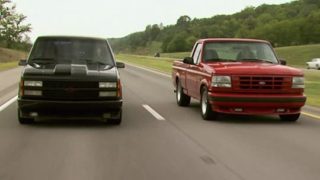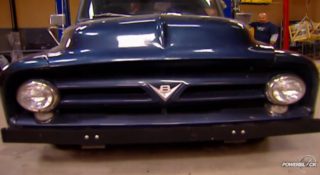More Super Dually Episodes
Trucks! Builds
Want more content like this?
Join the PowerNation Email NewsletterParts Used In This Episode
Blast-It-All
Media blaster equipment.
Certified Auto Recycling
1997 Dodge 2500 extended cab long bed chassis 12V Cummins motor.Rear Dually axle,front brake rotors, dually wheels.
Gerald's Auto Body
Frame alignment.
Kundel
Overhead crane system.
O'Reilly Auto Parts
Front Wheel Bearings and Grease Seals (Both Sides)
O'Reilly Auto Parts
Rear Wheel Bearings, Races and Seals
O'Reilly Auto Parts
Rear Brake Drums (2)
O'Reilly Auto Parts
Brake Shoes, Wheel Seal (2), Hardware Kit
O'Reilly Auto Parts
Spindle Lock Insert (rear)
O'Reilly Auto Parts
Wheel Cylinders (2)
Power Tool Box
Chicago Pneumatic QRS Series 5hp, 60 gallon, Rotary Screw Air Compressor with Refrigerated Dryer, Chicago Pneumatic RCP Series 2hp, 20 gallon Portable Air Compressor.
Episode Transcript
Today, the body snatchers are back on our diesel tow rig body swap project. We'll get our 97 dodges frame straightened out. Then we'll do a simple hug and axle swap to make it a duly. It's all today here on trucks.
Hey, welcome to trucks. Today, we're back on our diesel tow rig project. We're in the process of stripping parts off it so we can transplant some of this stuff into our classic Ford
to give you guys an idea on where this project got started.
Check this out.
We found the truck we wanted at certified auto recycling, but it wasn't perfect. But right here, we've got severe suspension damage, hit the wheel stuffed into the cap and even with the damage, it had everything else we needed for the basis of our next project.
And when this truck was wrecked, there's a combination of sheet metal suspension and even a little bit of frame damage. So we've shipped our chassis to Gerald's auto body to have it straightened. And we're gonna show you guys a little bit of insight as to what it takes to repair one of these heavy duty frames sitting underneath these trucks and while he's there, I'm gonna head back down to certified, pick up a few more parts that ought to help with the stability of our tow rig when dragging our enclosed trailer,
Gerald Martin started his first body shop in 1977 and has been continually growing. The business ever since.
The current location is 10,000 square feet with 17 employees and state of the art equipment.
So if you remember Gerald's auto body is the shop that gave us the estimate for our second chance Silverado to work from. So we got a big dodge locked down to the state of the art frame rack and we're going to pull this dude back into spec.
Now we've got alignment equipment back at the shop, but our little mighty pole is in no way strong enough to do a box frame like this one like we showed you before the wheel was stuffed back up under the cab and it kind of drug the suspension with it.
Gerald's frame technician Greg has been working on this a little bit and he's pulled the kink out of the frame, but the lower control arm is still back and the radiator support tab is still back a little bit. Now, we're gonna get to see some cool metal moving around. But what's really fascinating here is just how precise and accurate a laser alignment system like this is
with the laser scanner placed under a perfectly level frame it measures that frame three times a second and transfers that data to a computer.
The software contains measurements and specs for every single manufactured vehicle including our big dodge.
There are also points on the frame that are measured by the laser and compared to factory specs for proper realignment
that's accomplished by hanging flags from those strategic points and feeding the information via the laser back into the software.
However much the flags move during a poll tells a computer how much adjustment has been made and how much further you need to pull
the software even shows you detailed pictures where to hang your flags from the frame.
Once the flags have been identified by the laser, we're ready to start our pull and this machine doesn't play with over 10,000 P si of hydraulic pulling pressure
with the system measuring it three times a second. Greg has instant feedback that he can monitor during the poll.
He can actually watch the measurements change on the screen as he's straightening the frame.
Now, just like you've seen us do, Greg is tapping on the frame while it's under pressure. This relieves stress.
Patience is very important when pulling in aligning frames. And Greg Greenhaw has almost 20 years of experience in frame alignment
with the incredible amounts of force and pressure at play. Here. Safety is an obvious concern and a pull like this is better left to professionals like Gerald's Autobody
at home. You hadn't got nothing like it to pull.
You know, people used come alone with trees and tractors and everything else. But,
you know, when you put 78, 10,000 pounds of pressure to it,
that's a whole lot and you gotta have something to really hold it.
Now, check it out. That is actually a link from one of these pull chains that came apart under previous technicians pole while Greg likes to leave it there as a bit of a souvenir. The fact is that these box frames are some of the strongest out there and the most difficult to pull in a line.
Well, Greg taught us is that if your pull chains are straight and not twisted, well, it's safer, less likely for that to happen and you get a more accurate pull safety chains in place. Well, that stuff is just what experience teaches you.
Now, thanks to Gerald's Autobody in Pulaski, Tennessee, we can catch up with Ryan back at certified.
Now, the reason I made the trip back down here to certified auto recycling is so we could change our 2500 dodge ra M from a single rear wheel axle to a duly set up. Now, we know we're not going to change the load carrying capacity of our truck unless we change the leaf springs. But this wider Dooley axle will give us a lot more stability which comes in especially handy when tow and our enclosed trailer
to take a look at this axle, it's nice and clean. Even the rotor and the brake pads look usable.
Now, luckily for us, our truck is a two wheel drive. But if you guys are swapping this duly
axle into a four wheel drive, make sure you match up your ring and pinion ratio. Or else you're gonna be doing a ring and pinion swap. So
this duly
axle is huge, but there's one more piece of the puzzle.
Now, here's what's on our truck right now. If we tried to bolt a duly wheel to this, well, we'd have major interference problems. So what we're here to get is the hub spacers that'll change the offset of the wheel and give us plenty of clearance for our brake parts. That way we can run the same spare tire at all four corners of our truck.
Now, we've been down here picking up plenty of truck parts, but whether you need a window regulator for your minivan, a wheel for your daily driver or just a radio for your grocery getter. Well, certified auto recycling is a place to call. Let me get this stuff loaded up. I'm gonna hit the road
up next from the front to the back. We'll convert our truck to a dole
and later it's an easy drum break upgrade and overhaul. Stick around.
Hey, welcome back. Well, thanks to our Cundall crane. This featherweight engine and transmission dropped right back into place on our newly straightened frame. We just wanna say thanks to Greg and all the guys at Gerald's auto body.
Now, certified had a bunch of options for us, but here's what we ended up coming home with. This is a Dana 80 out of a 97 duly with 354 gears which should give us a reasonable highway cruise RPM and decent fuel economy. Now, this drum brake axle is a little bit cheaper than the disc brake axle. We showed you earlier and since our original truck head drums, well, it should drop right in without any modifications as far as stopping power goes. Well, we got a cheap upgrade to help these drums work a little bit better.
Now, unlike the separate rotor and wheel spacer assembly, we showed you earlier. Well, this is an integrated unit. The rotor seems to be in pretty good shape while we're installing them. We might as well throw in some fresh bearings, grease and a couple of new seals. Now, while we were down there, we also picked up a set of duly tires and wheels
while they look a little rough right now. Well, they won't, when we're done, we'll get them all cleaned up and hit them with some fresh paint. Ought to look like new as for the tires. Well, they're gonna hit the trash pile in favor of some more highway friendly rubber.
Now, one of the best things about switching over to a duly system is that all six wheels and tires can be rotated really increasing your tire life span.
Now, tear Hound's pretty straightforward. We'll pull a spindle nut and get the caliper safely out of the way. Like everything else on this truck. These things are heavy.
Oh,
now, we could have thrown these parts on like they were, but we thought we'd take a few minutes, throw them in the blast at all cabinet and get them ready for a fresh coat of paint.
And we also want to throw in a new set of wheel bearings. Now, driving the old races out, we could use a regular old chisel. But on the installation of the new races, you need to use a brass drip. That way you don't damage the surface of your new race
and you'll know when you've got them fully driven in because you'll get a solid metal on metal field.
Then it was time to make them look new again. And we did that by spraying on a fresh coat of semi gloss paint from DPA color.
And since I was a bit lazy and didn't mask off what I didn't wanna paint,
I'll use some brake clean to wipe off the rotor surface. So we didn't gum up our brake pads.
After that, we installed our freshly packed wheel bearings and a couple of new grease seals
that way the brakes and our wheel bearings on the front end of our dodge ought to be in good shape for quite a while.
Now, a little bit of axle grease on the spindle is just good insurance
and make sure you carefully install the hub. So you don't damage the seal on the sharp threaded end.
The hub gets followed by the prepacked outer wheel bearing the washer and then the spindle nut gets torque to spec and then backed off an eight of a turn,
then finally locked in place with a co
pin.
Now because of the depth of the spindle nut inside the Dooley hub, it can be a little tricky to put a cotter pin in. What we ended up doing was trimming a longer cotter pin down and installing it with needle nose pliers.
We reuse the original desk cap, tapping it in gently with a screwdriver and a soft face hammer.
Now, the single rear wheel axle we pulled out is also a Dana 80. We're going to keep it around just in case we can find another use for it in a project down the road.
Now, swapping the axle assemblies is pretty straightforward and can be done with basic tools, but we've gotten pretty used to our overhead crane.
Hey, welcome back to the shop.
Well, now that we've got our diesel tow rig project converted to a duly, we wanna pay attention to some maintenance issues before we go any further. So we're gonna pull these gigantic drums off our newly acquired axle. See what kind of shape the brakes are in.
Now, the axle we picked up, we had a few miles on it and it's well used. You guys know, sometimes getting these drums off can be a real bear.
It's frozen,
doesn't feel that cold.
Our brake drum had almost fused itself to the hub face. So with the use of some penetrating oil and a few more light taps on the hammer, we were able to break it free
but the shoes were still holding up. We had to take a different approach.
All right, here's the lock lever,
just roll the steer wheel down.
If we collapse those shoes enough, we can get this drum off.
Ah That's bad
JZ.
Now, they do make specialized break spring pliers to help remove the springs and retainers and they do come in handy,
but you can get by with just a couple of screwdrivers, a couple of pairs of pliers
and I know it looks a little intimidating with so much going on in here, but a good tip is to do one side at a time. That way you can use the completely assembled side as a reference.
Now, along with our brake shoes and drums, we also picked up a hardware kit.
So we're gonna be replacing some of the springs. But it's a really good idea to keep track of all the parts you remove
with the shoes loose. All that's left is removing the park and brake lever assembly from the rear shoe.
If you lose a little E clip here, don't spend too much time looking for it.
There should be one in the hardware kit
build on a budget truck projects that save you time and money.
Now, we had to replace our shoes and drums just because they were worn out. But here's a great cheap upgrade for you guys that drive full size dodges with drum brake axles that you can do whether your shoes need to be replaced or not.
What we're gonna do is replace the Dodge wheel cylinder with a one ton GM wheel cylinder. It's got a slightly larger board diameter. It's going to put more pressure on the shoes against the drums when you hit the pedal stopping your truck faster.
The best part about it, these wheel cylinders, they only cost about 12 bucks each
and it's the best way you can make your drum brake axle stop more like a disc brake axle. Just a lot cheaper.
Hey, thanks for sticking around. Well, we've got our new GM wheel cylinders installed. We're ready to move on with the rest of the break shoe installation.
But before you throw the new shoes on, go ahead and clean the contact points in between the shoes and the backing plate
and lubricate them with some lock tight ants.
Now, if you're working on drum brakes and you disassemble both sides and you don't have one side to look at as a reference,
but all that a diy is a great resource for step by step, instructions on how to do almost anything on a particular vehicle.
And I'm sure if you're doing this job without the specialized break spring pliers, well, it takes a little bit of extra patience.
Now each spring does a specific job and goes in a specific location. So make sure you get it right. You're just going to give yourself break issues down the road
and some of these springs are under a pretty fair amount of pressure. So just be aware of that.
And with the springs and shoes installed, we're almost ready to throw the drums on. But before we do that, we're going to make sure the self adjusting mechanism and star wheel spins freely works properly.
It should be a good starting spot.
Now, most rotors and drums come with a sprayed on coating on the friction service and that's there to prevent corrosion or rust while they're sitting on the parts store shelf.
So you need to make sure you remove it all before you install the parts.
Otherwise you'll be riding down the road with your brake smoking looking like they're on fire.
Ask me how I know
now we're ready to install the drum, but you can't just throw it on there and call it done. You need to have a slight interference fit between the drum and the shoes.
It's a little too loose.
But to expand the shoes where you just rotate the star wheel.
The only way it'll let you,
here we go.
Just a light, little bit of drag.
That's all you want.
Now, I've always said that your air compressor is the heart of your shop. And this two horse unit from Power toolbox.net. Well, it's affordable. It'll take care of your day to day needs even run some air tools if you need to. And with this compact size, you can throw it in the back of the truck and take it with you. But if you're running air tools more regularly or you're doing higher air volume requirement, jobs like spraying paint when you need to step up to a large capacity, piston type
compressor like this,
it can support up to 15 CFM at 100 P si and is able to run at a 75% duty cycle.
And even though it's a nice large compressor,
it's still rather affordable. But for the ultimate in compressed air performance, you want to go with a screw type unit like this five horse Chicago pneumatic compressor. This thing is all the bells and whistles, including the optional air dryer, which keeps your tools
protected and keeps all the contamination out of your paint. A screw type air compressor works exactly the same as the super charger in my truck in the parking lot. Very quiet, very efficient. And with its 100% duty cycle, this thing can run at max capacity all day long and give you perfectly clean dry air. 100% of the time.
All these compressors and a bunch of other cool tools are available at Power Tool box.net. Go check them out.
Now, if you have any questions about anything else you saw on today's show, go to Power Block tv.com
guys. Thanks for watching. See you next week.
Show Full Transcript
Hey, welcome to trucks. Today, we're back on our diesel tow rig project. We're in the process of stripping parts off it so we can transplant some of this stuff into our classic Ford
to give you guys an idea on where this project got started.
Check this out.
We found the truck we wanted at certified auto recycling, but it wasn't perfect. But right here, we've got severe suspension damage, hit the wheel stuffed into the cap and even with the damage, it had everything else we needed for the basis of our next project.
And when this truck was wrecked, there's a combination of sheet metal suspension and even a little bit of frame damage. So we've shipped our chassis to Gerald's auto body to have it straightened. And we're gonna show you guys a little bit of insight as to what it takes to repair one of these heavy duty frames sitting underneath these trucks and while he's there, I'm gonna head back down to certified, pick up a few more parts that ought to help with the stability of our tow rig when dragging our enclosed trailer,
Gerald Martin started his first body shop in 1977 and has been continually growing. The business ever since.
The current location is 10,000 square feet with 17 employees and state of the art equipment.
So if you remember Gerald's auto body is the shop that gave us the estimate for our second chance Silverado to work from. So we got a big dodge locked down to the state of the art frame rack and we're going to pull this dude back into spec.
Now we've got alignment equipment back at the shop, but our little mighty pole is in no way strong enough to do a box frame like this one like we showed you before the wheel was stuffed back up under the cab and it kind of drug the suspension with it.
Gerald's frame technician Greg has been working on this a little bit and he's pulled the kink out of the frame, but the lower control arm is still back and the radiator support tab is still back a little bit. Now, we're gonna get to see some cool metal moving around. But what's really fascinating here is just how precise and accurate a laser alignment system like this is
with the laser scanner placed under a perfectly level frame it measures that frame three times a second and transfers that data to a computer.
The software contains measurements and specs for every single manufactured vehicle including our big dodge.
There are also points on the frame that are measured by the laser and compared to factory specs for proper realignment
that's accomplished by hanging flags from those strategic points and feeding the information via the laser back into the software.
However much the flags move during a poll tells a computer how much adjustment has been made and how much further you need to pull
the software even shows you detailed pictures where to hang your flags from the frame.
Once the flags have been identified by the laser, we're ready to start our pull and this machine doesn't play with over 10,000 P si of hydraulic pulling pressure
with the system measuring it three times a second. Greg has instant feedback that he can monitor during the poll.
He can actually watch the measurements change on the screen as he's straightening the frame.
Now, just like you've seen us do, Greg is tapping on the frame while it's under pressure. This relieves stress.
Patience is very important when pulling in aligning frames. And Greg Greenhaw has almost 20 years of experience in frame alignment
with the incredible amounts of force and pressure at play. Here. Safety is an obvious concern and a pull like this is better left to professionals like Gerald's Autobody
at home. You hadn't got nothing like it to pull.
You know, people used come alone with trees and tractors and everything else. But,
you know, when you put 78, 10,000 pounds of pressure to it,
that's a whole lot and you gotta have something to really hold it.
Now, check it out. That is actually a link from one of these pull chains that came apart under previous technicians pole while Greg likes to leave it there as a bit of a souvenir. The fact is that these box frames are some of the strongest out there and the most difficult to pull in a line.
Well, Greg taught us is that if your pull chains are straight and not twisted, well, it's safer, less likely for that to happen and you get a more accurate pull safety chains in place. Well, that stuff is just what experience teaches you.
Now, thanks to Gerald's Autobody in Pulaski, Tennessee, we can catch up with Ryan back at certified.
Now, the reason I made the trip back down here to certified auto recycling is so we could change our 2500 dodge ra M from a single rear wheel axle to a duly set up. Now, we know we're not going to change the load carrying capacity of our truck unless we change the leaf springs. But this wider Dooley axle will give us a lot more stability which comes in especially handy when tow and our enclosed trailer
to take a look at this axle, it's nice and clean. Even the rotor and the brake pads look usable.
Now, luckily for us, our truck is a two wheel drive. But if you guys are swapping this duly
axle into a four wheel drive, make sure you match up your ring and pinion ratio. Or else you're gonna be doing a ring and pinion swap. So
this duly
axle is huge, but there's one more piece of the puzzle.
Now, here's what's on our truck right now. If we tried to bolt a duly wheel to this, well, we'd have major interference problems. So what we're here to get is the hub spacers that'll change the offset of the wheel and give us plenty of clearance for our brake parts. That way we can run the same spare tire at all four corners of our truck.
Now, we've been down here picking up plenty of truck parts, but whether you need a window regulator for your minivan, a wheel for your daily driver or just a radio for your grocery getter. Well, certified auto recycling is a place to call. Let me get this stuff loaded up. I'm gonna hit the road
up next from the front to the back. We'll convert our truck to a dole
and later it's an easy drum break upgrade and overhaul. Stick around.
Hey, welcome back. Well, thanks to our Cundall crane. This featherweight engine and transmission dropped right back into place on our newly straightened frame. We just wanna say thanks to Greg and all the guys at Gerald's auto body.
Now, certified had a bunch of options for us, but here's what we ended up coming home with. This is a Dana 80 out of a 97 duly with 354 gears which should give us a reasonable highway cruise RPM and decent fuel economy. Now, this drum brake axle is a little bit cheaper than the disc brake axle. We showed you earlier and since our original truck head drums, well, it should drop right in without any modifications as far as stopping power goes. Well, we got a cheap upgrade to help these drums work a little bit better.
Now, unlike the separate rotor and wheel spacer assembly, we showed you earlier. Well, this is an integrated unit. The rotor seems to be in pretty good shape while we're installing them. We might as well throw in some fresh bearings, grease and a couple of new seals. Now, while we were down there, we also picked up a set of duly tires and wheels
while they look a little rough right now. Well, they won't, when we're done, we'll get them all cleaned up and hit them with some fresh paint. Ought to look like new as for the tires. Well, they're gonna hit the trash pile in favor of some more highway friendly rubber.
Now, one of the best things about switching over to a duly system is that all six wheels and tires can be rotated really increasing your tire life span.
Now, tear Hound's pretty straightforward. We'll pull a spindle nut and get the caliper safely out of the way. Like everything else on this truck. These things are heavy.
Oh,
now, we could have thrown these parts on like they were, but we thought we'd take a few minutes, throw them in the blast at all cabinet and get them ready for a fresh coat of paint.
And we also want to throw in a new set of wheel bearings. Now, driving the old races out, we could use a regular old chisel. But on the installation of the new races, you need to use a brass drip. That way you don't damage the surface of your new race
and you'll know when you've got them fully driven in because you'll get a solid metal on metal field.
Then it was time to make them look new again. And we did that by spraying on a fresh coat of semi gloss paint from DPA color.
And since I was a bit lazy and didn't mask off what I didn't wanna paint,
I'll use some brake clean to wipe off the rotor surface. So we didn't gum up our brake pads.
After that, we installed our freshly packed wheel bearings and a couple of new grease seals
that way the brakes and our wheel bearings on the front end of our dodge ought to be in good shape for quite a while.
Now, a little bit of axle grease on the spindle is just good insurance
and make sure you carefully install the hub. So you don't damage the seal on the sharp threaded end.
The hub gets followed by the prepacked outer wheel bearing the washer and then the spindle nut gets torque to spec and then backed off an eight of a turn,
then finally locked in place with a co
pin.
Now because of the depth of the spindle nut inside the Dooley hub, it can be a little tricky to put a cotter pin in. What we ended up doing was trimming a longer cotter pin down and installing it with needle nose pliers.
We reuse the original desk cap, tapping it in gently with a screwdriver and a soft face hammer.
Now, the single rear wheel axle we pulled out is also a Dana 80. We're going to keep it around just in case we can find another use for it in a project down the road.
Now, swapping the axle assemblies is pretty straightforward and can be done with basic tools, but we've gotten pretty used to our overhead crane.
Hey, welcome back to the shop.
Well, now that we've got our diesel tow rig project converted to a duly, we wanna pay attention to some maintenance issues before we go any further. So we're gonna pull these gigantic drums off our newly acquired axle. See what kind of shape the brakes are in.
Now, the axle we picked up, we had a few miles on it and it's well used. You guys know, sometimes getting these drums off can be a real bear.
It's frozen,
doesn't feel that cold.
Our brake drum had almost fused itself to the hub face. So with the use of some penetrating oil and a few more light taps on the hammer, we were able to break it free
but the shoes were still holding up. We had to take a different approach.
All right, here's the lock lever,
just roll the steer wheel down.
If we collapse those shoes enough, we can get this drum off.
Ah That's bad
JZ.
Now, they do make specialized break spring pliers to help remove the springs and retainers and they do come in handy,
but you can get by with just a couple of screwdrivers, a couple of pairs of pliers
and I know it looks a little intimidating with so much going on in here, but a good tip is to do one side at a time. That way you can use the completely assembled side as a reference.
Now, along with our brake shoes and drums, we also picked up a hardware kit.
So we're gonna be replacing some of the springs. But it's a really good idea to keep track of all the parts you remove
with the shoes loose. All that's left is removing the park and brake lever assembly from the rear shoe.
If you lose a little E clip here, don't spend too much time looking for it.
There should be one in the hardware kit
build on a budget truck projects that save you time and money.
Now, we had to replace our shoes and drums just because they were worn out. But here's a great cheap upgrade for you guys that drive full size dodges with drum brake axles that you can do whether your shoes need to be replaced or not.
What we're gonna do is replace the Dodge wheel cylinder with a one ton GM wheel cylinder. It's got a slightly larger board diameter. It's going to put more pressure on the shoes against the drums when you hit the pedal stopping your truck faster.
The best part about it, these wheel cylinders, they only cost about 12 bucks each
and it's the best way you can make your drum brake axle stop more like a disc brake axle. Just a lot cheaper.
Hey, thanks for sticking around. Well, we've got our new GM wheel cylinders installed. We're ready to move on with the rest of the break shoe installation.
But before you throw the new shoes on, go ahead and clean the contact points in between the shoes and the backing plate
and lubricate them with some lock tight ants.
Now, if you're working on drum brakes and you disassemble both sides and you don't have one side to look at as a reference,
but all that a diy is a great resource for step by step, instructions on how to do almost anything on a particular vehicle.
And I'm sure if you're doing this job without the specialized break spring pliers, well, it takes a little bit of extra patience.
Now each spring does a specific job and goes in a specific location. So make sure you get it right. You're just going to give yourself break issues down the road
and some of these springs are under a pretty fair amount of pressure. So just be aware of that.
And with the springs and shoes installed, we're almost ready to throw the drums on. But before we do that, we're going to make sure the self adjusting mechanism and star wheel spins freely works properly.
It should be a good starting spot.
Now, most rotors and drums come with a sprayed on coating on the friction service and that's there to prevent corrosion or rust while they're sitting on the parts store shelf.
So you need to make sure you remove it all before you install the parts.
Otherwise you'll be riding down the road with your brake smoking looking like they're on fire.
Ask me how I know
now we're ready to install the drum, but you can't just throw it on there and call it done. You need to have a slight interference fit between the drum and the shoes.
It's a little too loose.
But to expand the shoes where you just rotate the star wheel.
The only way it'll let you,
here we go.
Just a light, little bit of drag.
That's all you want.
Now, I've always said that your air compressor is the heart of your shop. And this two horse unit from Power toolbox.net. Well, it's affordable. It'll take care of your day to day needs even run some air tools if you need to. And with this compact size, you can throw it in the back of the truck and take it with you. But if you're running air tools more regularly or you're doing higher air volume requirement, jobs like spraying paint when you need to step up to a large capacity, piston type
compressor like this,
it can support up to 15 CFM at 100 P si and is able to run at a 75% duty cycle.
And even though it's a nice large compressor,
it's still rather affordable. But for the ultimate in compressed air performance, you want to go with a screw type unit like this five horse Chicago pneumatic compressor. This thing is all the bells and whistles, including the optional air dryer, which keeps your tools
protected and keeps all the contamination out of your paint. A screw type air compressor works exactly the same as the super charger in my truck in the parking lot. Very quiet, very efficient. And with its 100% duty cycle, this thing can run at max capacity all day long and give you perfectly clean dry air. 100% of the time.
All these compressors and a bunch of other cool tools are available at Power Tool box.net. Go check them out.
Now, if you have any questions about anything else you saw on today's show, go to Power Block tv.com
guys. Thanks for watching. See you next week.



